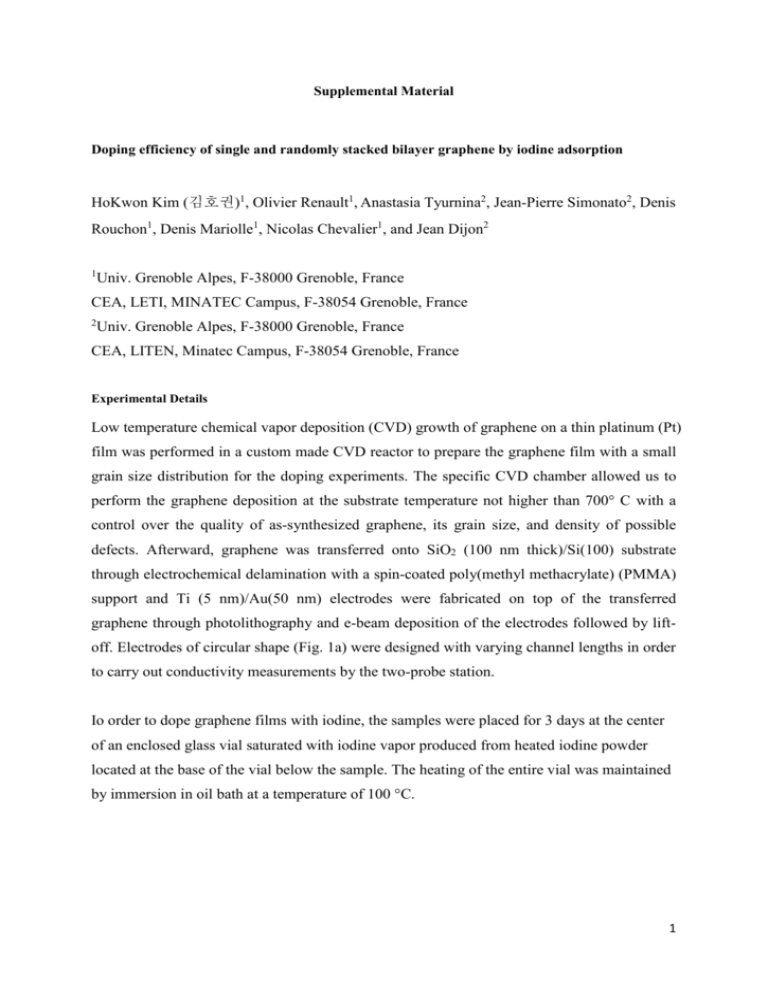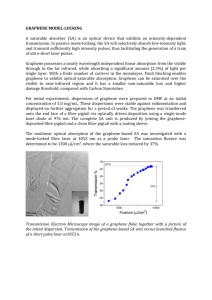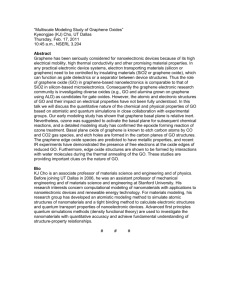Supplemental Material_H_Kim_revised
advertisement

Supplemental Material Doping efficiency of single and randomly stacked bilayer graphene by iodine adsorption HoKwon Kim (김호권)1, Olivier Renault1, Anastasia Tyurnina2, Jean-Pierre Simonato2, Denis Rouchon1, Denis Mariolle1, Nicolas Chevalier1, and Jean Dijon2 1 Univ. Grenoble Alpes, F-38000 Grenoble, France CEA, LETI, MINATEC Campus, F-38054 Grenoble, France 2 Univ. Grenoble Alpes, F-38000 Grenoble, France CEA, LITEN, Minatec Campus, F-38054 Grenoble, France Experimental Details Low temperature chemical vapor deposition (CVD) growth of graphene on a thin platinum (Pt) film was performed in a custom made CVD reactor to prepare the graphene film with a small grain size distribution for the doping experiments. The specific CVD chamber allowed us to perform the graphene deposition at the substrate temperature not higher than 700° C with a control over the quality of as-synthesized graphene, its grain size, and density of possible defects. Afterward, graphene was transferred onto SiO2 (100 nm thick)/Si(100) substrate through electrochemical delamination with a spin-coated poly(methyl methacrylate) (PMMA) support and Ti (5 nm)/Au(50 nm) electrodes were fabricated on top of the transferred graphene through photolithography and e-beam deposition of the electrodes followed by liftoff. Electrodes of circular shape (Fig. 1a) were designed with varying channel lengths in order to carry out conductivity measurements by the two-probe station. Io order to dope graphene films with iodine, the samples were placed for 3 days at the center of an enclosed glass vial saturated with iodine vapor produced from heated iodine powder located at the base of the vial below the sample. The heating of the entire vial was maintained by immersion in oil bath at a temperature of 100 °C. 1 (b) (a) 1L 2L counts I doped without doping counts I doped without doping 1200 1400 1600 2400 2600 2800 1200 1400 1600 wavenumber (cm-1) 2400 2600 2800 wavenumber (cm-1) Fig. S1 Raman spectra of graphene 1L (a) and 2L (b) areas. Excitation laser wavelength of 514 nm was used. Z X Range: 12.5 µm FM-KFM 2L 1L \ X Range: 25 µm [nm] CPD -572 mV -563 mV [µm] Fig. S2. Frequency modulated KFM measurements on 1L, folded 2L graphene on SiO2 illustrating surface topography, height profile and contact potential difference (CPD) related to the work function for 1L and 2L graphene. According to the CPD mapping, 1L and 2L graphene exhibit almost identical values with a difference close to the resolution limit (~ 10 mV). ptcr1362si. 1 ptcr1362si. 1 x 10 2 (b) Au 4f 25 O 1s 14 12 1000 800 600 400 Binding Energy (eV) 200 6 4 I 3d3/2 I 3d5/2 Au 4p 3/2 8 Au 4s Counts 0 Si 2s Si 2p O 2s 5 C 1s I 3d3/2 I 3d5/2 10 O KLM Counts 10 15 C 1s 20 Au 4d3/2 Au 4d5/2 (a) x 10 2 2 0 1000 800 600 400 200 Binding Energy (eV) Fig. S3. XPS survey spectra of SiO2 substrate (a) and Au electrode (b) regions. 2 Before Annealing 36000 28000 24000 32000 4.18eV 4.61eV 28000 Frequency 20000 Frequency After Annealing at 150 °C (b) (a) 16000 12000 8000 4000 24000 20000 16000 12000 8000 4000 0 0 4.0 4.1 4.2 4.3 4.4 4.3 4.4 Work function (eV) (c) 45 40 Name X=-774um, Y=1048um; CA=1500 um; EA1=2 mm X=-774um, Y=1048um; CA=1500 um; EA1=2 mm C1s Pos. 284.6361 285.3542 FWHM 0.8392 1.9578 Area 29.758 14.997 4.5 4.6 4.7 4.8 Work function (eV) %Area 66.49 33.51 (d) 95 Name X=-774um, Y=1048um; CA=1500 um; EA1=2 mm X=-774um, Y=1048um; CA=1500 um; EA1=2 mm C1s 90 Pos. 284.7797 285.4400 FWHM 0.8481 1.4017 Area 27.993 5.122 %Area 84.53 15.47 85 35 80 CPS CPS 30 25 75 20 70 15 65 10 60 5 290 55 289 288 287 286 285 Binding Energy (eV) 284 283 289 288 287 286 285 284 283 282 Binding Energy (eV) Fig. S4. Work function distribution histogram and C 1s spectra of as-transferred graphene before (a,c) and after annealing (b,d). 3






